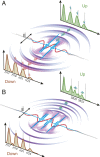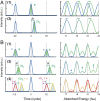Controlling photoionization using attosecond time-slit interferences
- PMID: 32354996
- PMCID: PMC7245115
- DOI: 10.1073/pnas.1921138117
Controlling photoionization using attosecond time-slit interferences
Abstract
When small quantum systems, atoms or molecules, absorb a high-energy photon, electrons are emitted with a well-defined energy and a highly symmetric angular distribution, ruled by energy quantization and parity conservation. These rules are based on approximations and symmetries which may break down when atoms are exposed to ultrashort and intense optical pulses. This raises the question of their universality for the simplest case of the photoelectric effect. Here we investigate photoionization of helium by a sequence of attosecond pulses in the presence of a weak infrared laser field. We continuously control the energy of the photoelectrons and introduce an asymmetry in their emission direction, at variance with the idealized rules mentioned above. This control, made possible by the extreme temporal confinement of the light-matter interaction, opens a road in attosecond science, namely, the manipulation of ultrafast processes with a tailored sequence of attosecond pulses.
Keywords: attosecond pulses; electron momentum spectroscopy; photoelectric effect; photoionization.
Copyright © 2020 the Author(s). Published by PNAS.
Conflict of interest statement
The authors declare no competing interest.
Figures





References
-
- Planck M., Ueber das gesetz der energieverteilung im normalspectrum. Ann. Phys. 309, 553–563 (1901).
-
- Einstein A., Über einen die erzeugung und verwandlung des lichtes betreffenden heuristischen gesichtspunkt. Ann. Phys. 322, 132–148 (1905).
-
- Laporte O., Meggers W. F., Some rules of spectral structure. J. Opt. Soc. Am. A 11, 459–463 (1925).
-
- Yang C. N., On the angular distribution in nuclear reactions and coincidence measurements. Phys. Rev. 74, 764–772 (1948).
-
- Cooper J., Zare R. N., Angular distribution of photoelectrons. J. Chem. Phys. 48, 942–943 (1968).
LinkOut - more resources
Full Text Sources

